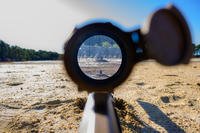When we hear a battlefield valor story about a soldier throwing himself on a grenade to save a friend or battle buddy, that's usually the end of the story. For Cpl. Clair Goodblood, it was just the beginning.
Goodblood was a soldier who first enlisted in the U.S. Army in 1947. His first posting was to Alaska, where he served as a chaplain's assistant. He reenlisted in 1950, the same year that North Korea sent its forces into South Korea, sparking off the three-year Korean War.
He was transferred from Alaska to the undermanned 3rd Infantry Division, 7th Infantry Regiment shortly after. By Aug. 20, 1950, the 3rd Infantry Division was on its way to Wonson, Korea, where it would arrive on Nov. 21. Among their first tasks was covering the retreat of Task Force Faith from the Battle of the Chosin Reservoir.
Next, Goodblood and the 7th Infantry Regiment held the line around Hungnam as the United Nations forces successfully evacuated troops and materiel in the face of the surprise Chinese counterattack. Some 100,000 United Nations forces and 86,000 North Korean refugees were moved in a sealift operation that lasted nine days and is now known as the "Miracle of Christmas."
The 7th Infantry Regiment was the last unit off of Hungnam's Pink Beach.
By April 1951, Goodblood and the 7th were north of the South Korean capital of Seoul, among the first line of defense against the Chinese People's Liberation Army's 1951 Spring Offensive. It was here that Cpl. Goodblood would enter history books.
As the UN positioned itself to retake the offensive over the 38th Parallel and take the fight back to North Korea, the Chinese moved first. With 700,000 men, the PLA suddenly struck the underprepared UN lines on April 22, 1951, all along the front line.

In the area around Popsu-dong, 29 miles north of Seoul, Goodblood was a machine gunner for Company D, 1st Battalion, but was defending Company B's perimeter in a thickly wooded area. On the night of April 24, the perimeter was suddenly swarmed by incoming Chinese troops.
Overwhelmed by the volume of attackers, the Americans were ordered to fall back. Goodblood volunteered to man his gun to cover their withdrawal. He and his assistant put the machine gun to work as his fellow soldiers escaped the onslaught, but caught sight of a grenade that was thrown into his position.
Goodblood pushed his assistant aside and attempted to take the full force of the explosion himself, throwing his body on top of his fellow soldier. Both men were wounded, but Goodblood ordered an ammunition bearer to evacuate his assistant as he retook his position on the gun.

Wounded, Goodblood refused to be evacuated himself and continued pouring rounds into the enemy attackers. Finally, with all his comrades falling back, the Chinese mounted a "banzai charge" and were able to take down the soldier and silence his machine gun.
When the U.S. and UN forces were able to retake the lost ground from the Chinese the next day, they found Goodblood's body beside his machine gun and around 100 dead enemy troops in his field of fire. His sacrifice allowed the company to regroup in the face of the surprise assault and retake their position.
On Jan. 16, 1952, Goodblood's mother received his Medal of Honor from Secretary of Defense Robert A. Lovett at a Pentagon ceremony. On Memorial Day 1998, the Cpl. Clair Goodblood Medal of Honor Memorial was dedicated in Burnham, Maine's Chandler Cemetery, where he was buried.
-- Blake Stilwell can be reached at blake.stilwell@military.com. He can also be found on Twitter @blakestilwell or on Facebook.
Want to Learn More About Military Life?
Whether you're thinking of joining the military, looking for post-military careers or keeping up with military life and benefits, Military.com has you covered. Subscribe to Military.com to have military news, updates and resources delivered directly to your inbox.
















